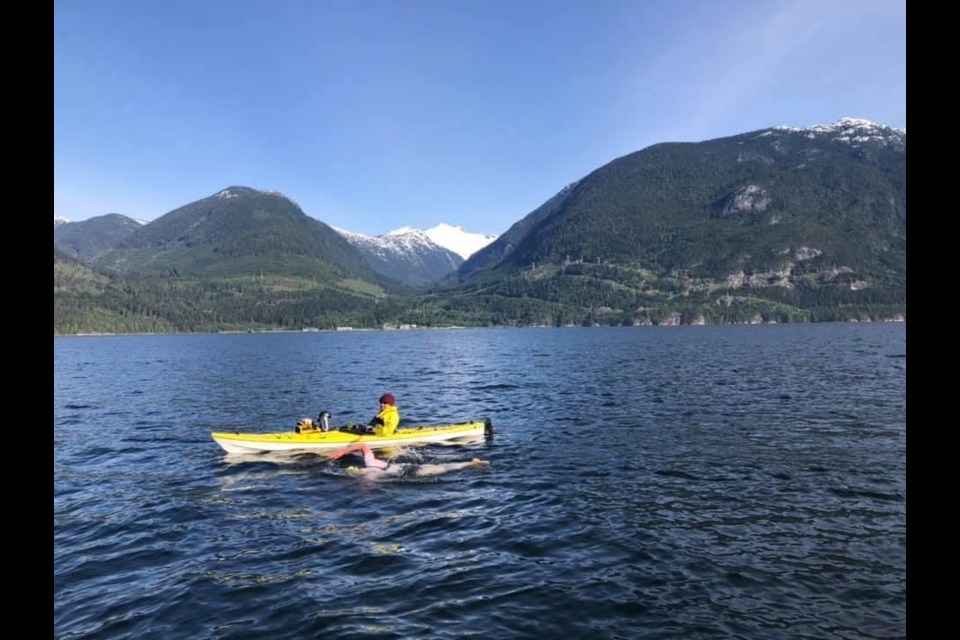On floor of Howe Sound, cities of silica teeming with life filter through billions of litres of water every day.
That is, until a prawn trap, a crab trap, an anchor punches through their delicate skeletons.
It’s in the waters breathed through the centuries-old structures, marathon swimmer Jessi Harewicz takes on her latest challenge – “swimming the surface to protect the depth.”
Harewicz is circumnavigating all of the Átl’ḵa7tsem/Howe Sound islands (or island groups) to build awareness of glass sponge reefs and their need for protection.
The channel swimmer – the third Canadian to achieve the triple crown of open water swimming – takes to the water wearing just a bathing suit, cap, goggles and a ton of sunscreen (and with a support boat nearby). In 2018, the Vancouverite swam around Bowen Island with the quiet hope of someday swimming all of the Sound islands. COVID-19 and the cancellation of other swims provided the space and time for the project.
She started with the Defence Islands in early May, then in late May, Harewicz swam the 12.9 km around Keats. At the beginning of June, she swam 10.8 km around the Pasleys, and then the 18.2 km of Lhaxwm/Anvil on June 10 and the 36.1 km of Cha7élkwnech/Gambier on June 23.
When the waters cool in the fall, Harewicz plans on finishing the Sound – Bowyer and Passage Islands.
For several of the circumnavigations, this was the first logged swim.
Harewicz also swam right over at least two glass sponge reefs and will swim over a third in the fall, said Glen Dennison. He would know. For decades, the Marine Life Sanctuaries Society director has been at the forefront of discovering and advocating for the glass sponge reefs.
Though the reefs are pre-Cretaceous, they were thought extinct until the 1980s, when scientists discovered live ones off the B.C. coast. And the Howe Sound reefs, just under a dozen of which are protected under Department of Fisheries and Oceans (most, if not all, discovered by MLSS and its volunteers), are the healthiest in the world, according to Dennison.
He described them as an alien world. “You drop through this jet black water and all of a sudden, the bottom starts to light up everywhere.”
“You can see the undulations and fields of sponge, as the bottom contours change,” he said.
“They stand sometimes almost two and a half metres tall down there. And they look like Dr. Seuss figures.”
For Dennison, partnering with Harewicz allows the opportunity to bring the deep sea creatures further into public light. “This was a good way to build awareness for people who don’t really know a lot about it and are continuing to do contact fishing on the reefs.”
There are marine refuges scattered throughout the sound, created to protect known reefs by banning prawn and crab traps, shrimp and groundfish trawls, groundfish hook and line, and the use of downrigger gear, but at least five DFO-acknowledged living reefs in the Sound remain unprotected.
Though the reefs are exceedingly rare, they still see damage from bottom contact fishing – like the reef off Dorman Point. “One time I went over top of it and it had a four-by-four cookie-cutter hole in the sponge that was deep enough you could actually descend into it as a diver,” recounted Dennison. The crushed sponge at the bottom of the crater was “white, beautiful live sponge.”
“A year later, when I went back, it was a 20 foot soft slope crater that was black,” he said. “This is why it’s really important to keep those traps off there. Because it’s out of sight, it’s out of mind.”
Glass sponge reefs can remove organic carbon at rates similar to kelp forests and old growth forests, according to a 2020 DFO report and grow between one and nine centimetres a year, making recovery rates low.
While cold water is necessary for sponge reefs and their inhabitants, it’s also necessary for marathon swimming. “I was so ill at Gambier, it was one of the hottest swims I think I’ve ever done,” said Harewicz. “And it’s really sad when you know that all this heat, and all of these other factors, are affecting the water that you’re physically touching and seeing and smelling and tasting.
“It’s hard when you submerse yourself into water, and smell and taste things that only few people I think have done,” she said.
But she also wants to build awareness of the low-impact recreational potential of Howe Sound.
“You can take it in sections,” she suggested. “I know people, even on Bowen, and I’m like, ‘Hey, we should go and swim next to the cedar logs in the back end of Gambier – do you know, it actually smells amazing.'”
For more information about Harewicz’ Átl’ḵa7tsem/Howe Sound Swimming Project on the MLSS website.
With files from Brent Richter / North Shore News; Sophie Woodrooffe / Coast Reporter



